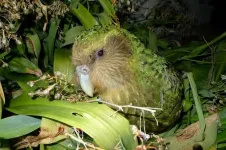(Press-News.org) Constantina Theofanopoulou wanted to study oxytocin. Her graduate work had focused on how the hormone influences human speech development, and now she was preparing to use those findings to investigate how songbirds learn to sing. The problem was that birds do not have oxytocin. Or so she was told.
"Everywhere that I looked in the genome," she says, "I was unable to find a gene called oxytocin in birds."
Theofanopoulou eventually came across mesotocin, the analogue for oxytocin in birds, reptiles, and amphibians. But as she plumped the literature in Erich Jarvis's lab at Rockefeller, the waters grew muddier. If she and Jarvis wanted to find studies on oxytocin in fish, they had to remember to search for the unique term isotocin. Unless, of course, they were looking for studies of oxytocin in certain species of shark, in which case they were obliged to scour abstracts for valitocin--the oxytocin of spiny dogfish. Similar issues arose when they tried studying the hormone vasotocin in birds, which is called vasopressin in humans. And the oxytocin receptor, typically abbreviated OXTR in mammalian studies, could be named VT3, MTR, MesoR, or ITR in studies of other species.
"I started getting lost," Jarvis admits. "I said, before we dig deeper, we need to make sure we've made the right assumptions about which human and bird genes are evolutionarily related."
Now, in a new study in Nature, Theofanopoulou and Jarvis demonstrate that the human hormone known as oxytocin is in fact the one and the same gene across all major vertebrate lineages. The similarities are in fact so striking that the scientists advocate for cleaning up the jargon once and for all by applying new standard nomenclature for the hormones known as oxytocin and vasopressin in humans, as well as their respective receptors.
This updated naming convention would, at the very least, make life easier for scientists studying oxytocin. But it could also serve as a model for how to translate a vast range of biological findings across species--ultimately leading to a better understanding of how the same genes function in different organisms.
A Whole-Genome Approach
Before whole genome sequencing gave scientists a big picture view of just how similar many genetic sequences are, biochemists would often assign unique names to near-identical genes in recognition of slight, often inconsequential, differences. This gave rise to the odd naming conventions across species that so baffled Theofanopoulou and Jarvis. "Oxytocin in mammals has one different amino acid than mesotocin in turtles," Theofanopoulou says. "Before we had a whole-genome perspective, we might have thought that it was an entirely different gene."
But sequence similarity isn't the only sign that two genes from different species are related. Another is each gene's surrounding gene territory on its respective chromosome, which scientists refer to as synteny. In other words, the identity of a gene is not made up only by the sequence 'inside' the gene, but also by the genes that surround it, those genes found 'outside' that gene. And while mammalian oxytocin differs slightly, in sequence, from its turtle analogue, this new study demonstrates that there is synteny in oxytocin, vasotocin, and each hormone's receptor, across the genomes of 35 species that span all major vertebrate lineages and four invertebrate lineages.
"With synteny, we can show that oxytocin in mammals is the same gene as mesotocin in turtles, because it is located in the same syntenic position in all these genomes, namely surrounded by the same genes across species. Gene sequence within a gene tends to change fast, but the gene order, how genes are located the one after the other, tends to be much more conserved in evolutionary time." Theofanopoulou says.
This broader perspective would not have been possible without recent updates that made whole genomes more complete and accurate, a project spearheaded by the international Vertebrate Genomes Project, which Jarvis chairs. These use long-sequence reads and long-range data to generate nearly complete chromosomal level genome assemblies. Cleaner genomes with fewer errors allow scientists to search for syntenic subtleties in new ways. "Many of the genomes that we have been looking at don't have mixed up chromosomes or errors," Jarvis says. "Nobody had this before."
What's in a name?
Many more genes may require just this sort of re-evaluation, to facilitate translational research and bring scientific vocabulary into the post-genomic era. For instance, similar nomenclature issues exist within two genes pertinent to Jarvis's work on vocal learning, SRGAP and FOXP2, and Theofanopoulou suspects that naming conventions for dopamine and estrogen receptors may need revisions as well. "This paper serves as a model for how to revamp genome nomenclature in biology, based on gene evolution," Jarvis says.
But whether such new names will stick remains an open question. Jarvis and Theofanopoulou are already experiencing pushback from researchers who are reluctant to see the long legacy of mesotocin research renamed and bundled up with oxytocin, or vasopressin with vasotocin. "We've spoken with several people who knew that these genes were analogues but insisted that they cannot be called by the same name," Jarvis says. "Some argued that 'this is the way it has been for decades.'"
Others worry that, however syntenic these genes may be across species, it would be inaccurate and perhaps even misleading to use the same name for the gene that promotes lactation in mammals and clearly plays a different role in birds and turtles. Jarvis disagrees. "A name shouldn't be based solely on function, but also on genetic and evolutionary similarities," he says.
"We can now show that these are the same genes because they are located in the same conserved blocks of gene order in the genome across species," Theofanopoulou adds. "Had the genes for these hormones been discovered in today's genomics era, they would have been named with the same and not different names."
INFORMATION:
Researchers from Erasmus School of Economics, IESE Business School, and New York University published a new paper in the Journal of Marketing that examines what business schools do wrong when conducting academic research and what changes they can make so that research contributes to improving society.
The study, forthcoming in the Journal of Marketing, is titled "Faculty Research Incentives and Business School Health: A New Perspective from and for Marketing" and is authored by Stefan Stremersch, Russell Winer, and Nuno Camacho.
In February 2020, an article in ...
The flightless kakapo of New Zealand is in trouble. The world's heaviest parrot--representing one of the most ancestral branches of the parrot family tree--is nearly extinct, with barely 200 adults plodding the underbrush of four small islands. Whether the last of the kakapos had the genetic resilience to survive was a question that only high-quality genomic analysis could answer.
But a high-quality genome assembly did not exist for the kakapo--nor for most of the 70,000 vertebrate species alive today.
Questions about how best to prevent the extinction of species ranging ...
ROCHESTER, Minn. -- Difficult-to-treat, chronic wounds in preclinical models healed with normal scar-free skin after treatment with an acellular product discovered at Mayo Clinic. Derived from platelets, the purified exosomal product, known as PEP, was used to deliver healing messages into cells of preclinical animal models of ischemic wounds. The Mayo Clinic research team documented restoration of skin integrity, hair follicles, sweat glands, skin oils and normal hydration.
Ischemic wounds occur when arteries are clogged or blocked, preventing important nutrients and oxygen from reaching the skin to drive repair. This groundbreaking study titled, "TGF-β Donor Exosome Accelerates Ischemic ...
To be more energy efficient, many people have replaced their incandescent lights with light-emitting diode (LED) bulbs. However, those currently on the market emit a lot of blue light, which has been linked to eye troubles and sleep disturbances. Now, researchers reporting in ACS Applied Materials & Interfaces have developed a prototype LED that reduces -- instead of masks -- the blue component, while also making colors appear just as they do in natural sunlight.
LED light bulbs are popular because of their low energy consumption, long lifespan and ability to turn on and off quickly. Inside the bulb, an LED chip converts electrical current into high-energy light, including invisible ultraviolet (UV), violet ...
The highly infectious SARS-CoV-2 variant that recently emerged in South Africa, known as B.1.351, has scientists wondering how existing COVID-19 vaccines and therapies can be improved to ensure strong protection. Now, researchers reporting in ACS' Journal of Medicinal Chemistry have used computer modeling to reveal that one of the three mutations that make variant B.1.351 different from the original SARS-CoV-2 reduces the virus' binding to human cells -- but potentially allows it to escape some antibodies.
Since the original SARS-CoV-2 was first detected in late 2019, several new variants have emerged, including ones from the U.K., South Africa and Brazil. Because the new variants appear to be more highly ...
Uncapped, idle oil wells could be leaking millions of kilograms of methane each year into the atmosphere and surface water, according to a study by the University of Cincinnati.
Amy Townsend-Small, an associate professor of geology and geography in UC's College of Arts and Sciences, studied 37 wells on private property in the Permian Basin of Texas, the largest oil production region on Earth. She found that seven had methane emissions of as much as 132 grams per hour. The average rate was 6.2 grams per hour.
"Some of them were leaking a lot. Most of them were leaking a little or not at all, which is a ...
April 28, 2021 -- Using naturalistic driving data and machine learning techniques, researchers at Columbia University Mailman School of Public Health and Columbia's Fu Foundation School of Engineering and Applied Science have developed highly accurate algorithms for detecting mild cognitive impairment and dementia in older drivers. Naturalistic driving data refer to data captured through in-vehicle recording devices or other technologies in the real-world setting. These data could be processed to measure driving exposure, space and performance in great detail. The findings are published in the journal Geriatrics.
The researchers developed random forests models, a statistical technique ...
People of color, those with a higher income and younger individuals are more likely to participate in clinical trials during their cancer treatment according to a new study from the University of Missouri School of Medicine.
Clinical trials are research studies that involve people who volunteer to take part in tests of new drugs, current approved drugs for a new purpose or medical devices.
The study analyzed data collected from the Centers for Disease Control and Prevention (CDC) Behavioral Risk Factor Surveillance System Survey, which is an annual national telephone survey designed to collect health-related data from U.S. adults. Survey years selected included the question, "Did you participate in a clinical trial ...
Chocolate is a beloved treat, but sometimes the cocoa beans that go into bars and other sweets have unpleasant flavors or scents, making the final products taste bad. Surprisingly, only a few compounds associated with these stinky odors are known. Now, researchers reporting in ACS' Journal of Agricultural and Food Chemistry have identified the two compounds that cause musty, moldy scents in cocoa -- work that can help chocolatiers ensure the quality of their products.
Cocoa beans, when fermented correctly, have a pleasant smell with sweet and floral notes. But they can have an off-putting scent when fermentation goes wrong, or when storage conditions ...
When seasonal rains arrive late in Indonesia, farmers often take it as a sign that it is not worth investing in fertilizer for their crops. Sometimes they opt out of planting annual crops altogether. Generally, they're making the right decision, as a late start to the rainy season is usually associated with the state of El Niño Southern Oscillation (ENSO) and low rainfall in the coming months.
New research published in the Nature journal Scientific Reports shows that ENSO, the weather-shaping cycle of warming and cooling of the Pacific Ocean along the Equator, is a strong predictor of cacao harvests up to two years before a harvest.
This is potentially ...



